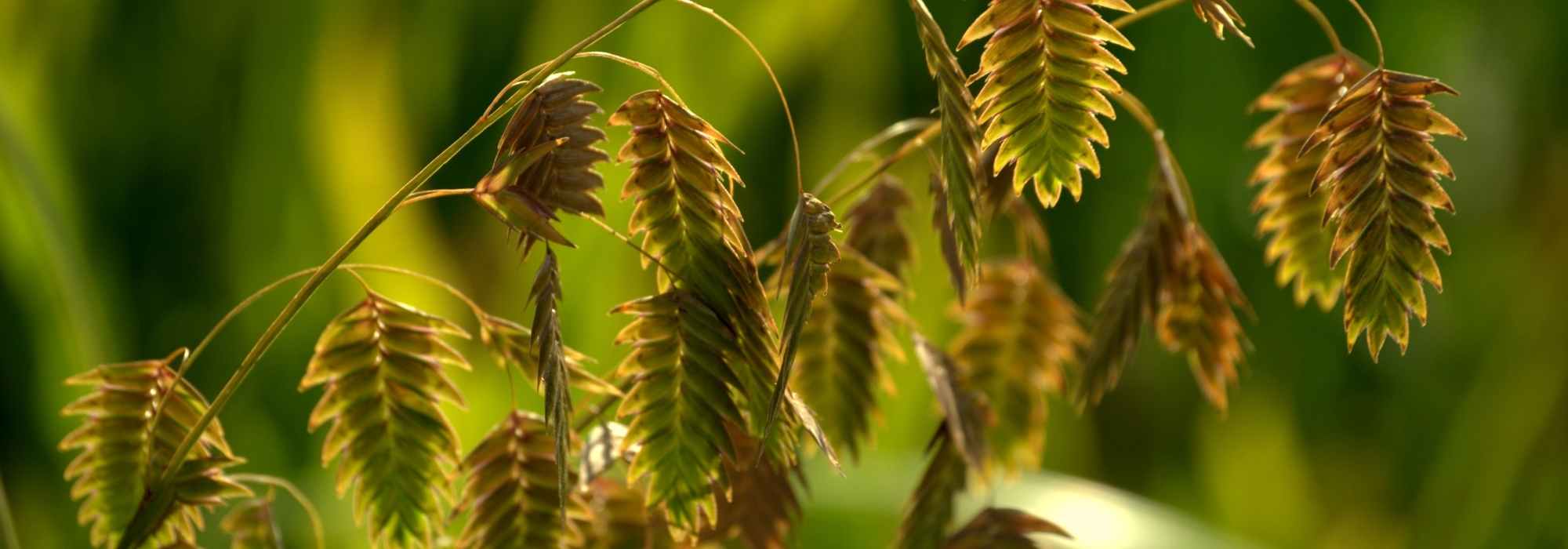
Chasmanthium latifolium, wild oats: planting and care
Contents
Chasmanthium in a nutshell
- Chasmanthium latifolium is a beautiful perennial grass all year round
- The foliage of woodland oats resembles that of bamboo, but its colours change with the seasons
- The inflorescence of wild oats is light, pendulous, but above all very original
- You can grow chasmanthium in full sun or partial shade.
- This perennial is hardy and thrives in any cool, well-drained soil.
The word from our expert
There are six species of Chasmanthium, but only Chasmanthium latifolium is cultivated here. It is an interesting perennial grass for several reasons. Its green foliage somewhat resembles that of bamboo, except that it luxuriously changes colour gradually in autumn and then in winter: shifting from bronze-orange to beige-fawn. There is even a variety with variegated white foliage: Chasmanthium latifolium ‘River Mist’.
In addition, it has a flowering period in late summer that extends into the heart of autumn. A quite unique inflorescence, light and pendulous, with spikelets that resemble tiny crushed pine cones clashing at the slightest breeze. These flowers will also change colour throughout the seasons, putting on a final display in winter when frost enhances them for one last performance.
Wild oats, one of its common names, can be used in multiple ways in the garden. It will thrive at the edge or within a border, in groups, as groundcover, and even in pots. Very hardy and low-maintenance, woodland oats require only one pruning a year after winter and occasional watering.
If you wish to welcome it into your home, you will find it very accommodating. It enjoys full sun or partial shade in any ordinary soil, more or less rich, as long as it remains cool and well-drained.
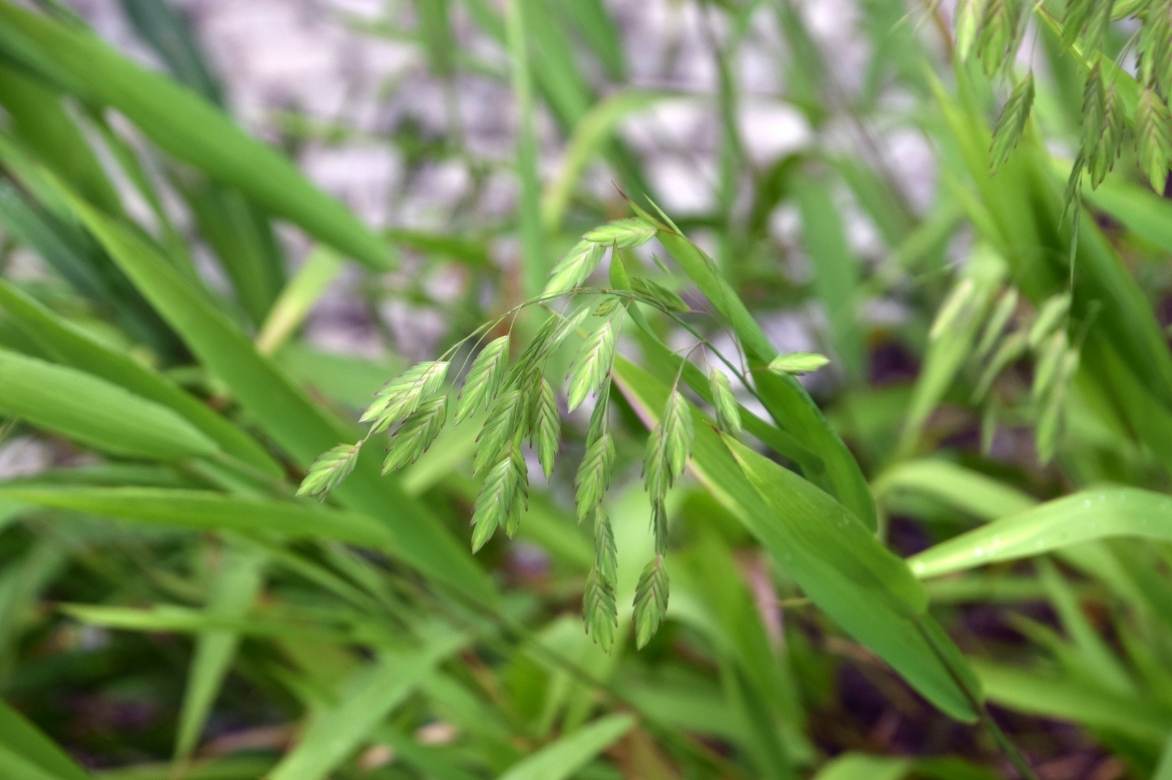
Chasmanthium latifolium
Botany and description
Botanical data
- Latin name Chasmanthium sp., Chasmanthium latifolium
- Family Poaceae
- Common name Wild Oat, Wood Oat
- Flowering late August to October
- Height 150 cm
- Exposure sun and partial shade
- Soil type ordinary, cool but well-drained
- Hardiness -20°C
The genus Chasmanthium belongs to the family Poaceae, formerly known as “grasses”, and comprises 6 species. Only the species Chasmanthium latifolium, native to the United States, is cultivated in our gardens. Its natural distribution covers a large part of the United States, extending even to Manitoba (Canada) and northeastern Mexico. This grass, sometimes referred to as “wild oat” or “wood oat”, primarily grows along riverbanks and in deciduous woods. It is worth noting that the plant was previously classified in the genus Uniola, so you may occasionally find this grass in literature under its former name Uniola latifolia.
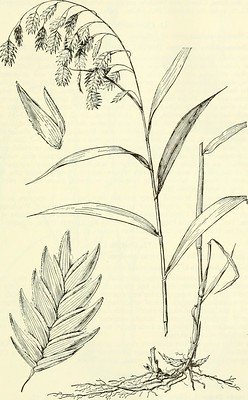
Chasmanthium latifolium, botanical illustration from 1972
Wild oat is a perfectly hardy grass, able to withstand frosts down to -25°C.
The Chasmanthium latifolium has a short rhizome root system and the plant remains well tufted. This grass is a perennial with deciduous foliage, which is renewed each year. The leaves, measuring 10 to 20 cm long, are lanceolate with distinct transverse veins, somewhat reminiscent of bamboo foliage. These leaves, soft and arching, are green (lighter in the sun than in the shade) and turn yellow-orange in autumn after the first frosts, eventually becoming completely brown in winter. The foliage of the variety ‘River Mist’ is beautifully variegated with cream-white in season, ideal for brightening up partially shaded areas.
The culms (stems) can grow to over a metre. Ultimately, the mature plant in flower forms a clump 100 to 150 cm high and 60 cm wide in rich, cool soil. Without the inflorescences, the plant does not exceed 80 cm in height.
The inflorescence resembles that of oats, hence the common names: wild oat or wood oat. It consists of oval, open panicles, measuring 10 to 35 cm long and pendulous at the ends of the culms. These panicles are made up of solitary, pedicellate spikelets, hanging and laterally compressed, reminiscent of tiny flattened pine cones. The spikelets are initially green, adopting a bronze-red hue in autumn and then light tawny as they dry. The inflorescences remain very attractive in winter when covered with frost or snow. Flowering begins in late August and lasts until the heart of autumn.
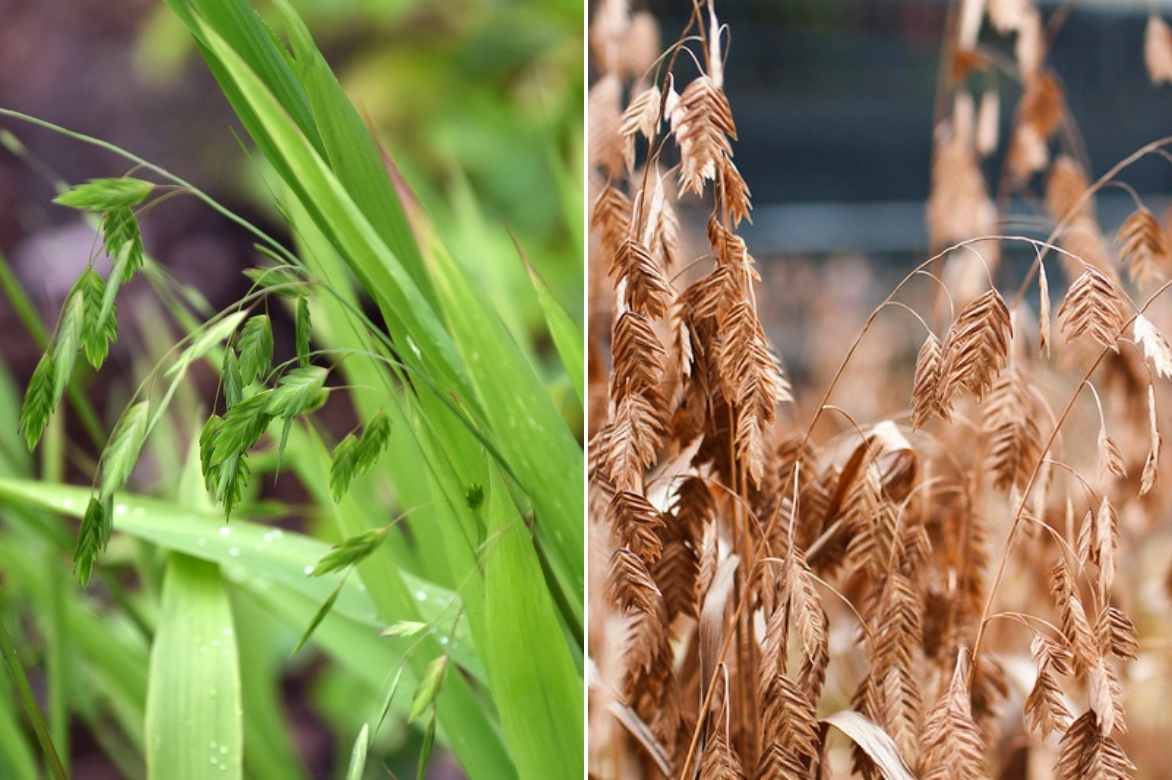
Chasmanthium latifolium, foliage and inflorescences in spring and winter (photo on the right © Josiah Lau Photography)
Read also
Grasses: which variety to choose?The main varieties
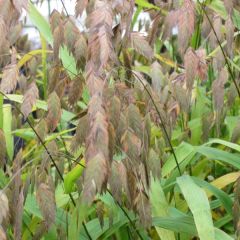
Chasmanthium latifolium
- Flowering time October, November
- Height at maturity 80 cm
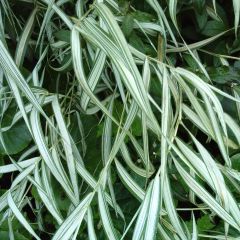
Chasmanthium latifolium River Mist
- Flowering time October, November
- Height at maturity 60 cm
Discover other Chasmanthium
View all →Available in 1 sizes

Available in 2 sizes

Available in 2 sizes
Planting Chasmanthium latifolium
Where to plant?
Chasmanthium latifolium thrives in full sun or partial shade, but the leaves will be more upright in full sun, adopting an almost columnar habit. Note that in full sun, the wild oats will require soil that remains cool to moist, while in partial shade, it will tolerate dry spells without issue. However, in full sun, the colours of the foliage and the spikes will be more intense in autumn.
This grass is content with any ordinary soil, even clayey, that remains cool in summer but is well-drained and, if possible, rich.
Wild oats can be used as groundcover, within borders, in groups to form a meadow, or even in pots.
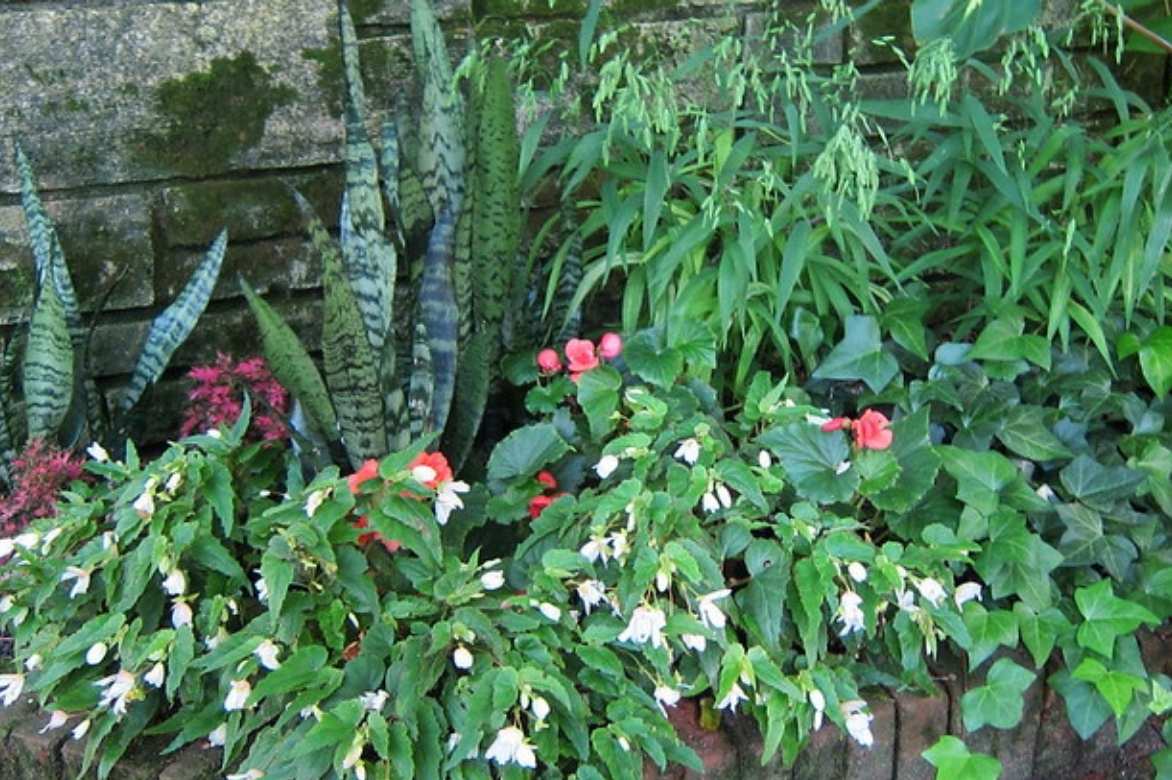
Chasmanthium latifolium in the background on the right, alongside Begonias ‘Marschmallow’, Sanseveria trifasciata, and Coleus ‘Smoky Rose’ (© Cultivar 413)
When to plant?
From February to April if your winters are cold and wet and in heavy soil, or from September to November.
How to plant?
Chasmanthiums can be planted at a rate of five pots per m² for a quick mass effect. Space them about 50 cm apart.
- Soak the root ball in water for a few minutes;
- Remove from the pot, check the roots, and gently untangle them if necessary;
- Dig a hole twice as wide and twice as deep as the root ball of your plant;
- Loosen the soil at the bottom of the hole;
- Add some sand or small gravel if your soil is too heavy;
- Incorporate some well-rotted compost;
- Place the root ball at the bottom of the hole;
- Backfill the hole and firm the soil around the clump with your hands;
- Water thoroughly to eliminate any “air pockets” between the soil and the roots;
- Apply a good mulch at the base: flax shavings, miscanthus, or simply grass clippings.
For pot planting: use a terracotta pot with a drainage hole. Fill the bottom of the pot (1/5) with clay balls and prepare a draining substrate (1/3 garden soil, 1/3 sand, and 1/3 good potting soil).
Read also
Planting grassesCaring for Chasmanthium latifolium
Care requirements
Remember to keep the soil moist around your chasmanthiums by applying mulch. If the plant is in a pot, be sure to water it regularly. In open ground, the plant withstands drought well, but at the expense of beautiful foliage and inflorescence. However, do not forget to water during the first year following planting.
A spring application of compost at the base of the grasses is always appreciated.
If the plant is young and planted in full sun, consider protecting the clump from spring frosts with a layer of dead leaves. The plant is very hardy, but it can happen that young shoots start early in the season, which poses a risk to them.
Pruning
Pruning is done by cutting back the old culms at the end of winter in March, before the resumption of growth.
Diseases and pests
Very hardy and very easy to cultivate, Chasmanthium latifolium is also unaffected by any diseases or pests.
Multiplying Chasmanthium latifolium
Clumps can be divided every 3 to 4 years, in spring or autumn. Simply lift the clump using a garden fork and then gently separate the clumps by hand.
Alternatively, you may also be fortunate enough to see spontaneous sowings of Chasmanthium in damp gardens. All you need to do is move them as necessary, with a clod of earth, in spring. Wood oats never become invasive, as the small shoots can be easily removed.
How to pair Chasmanthium latifolium?
You can create a lovely autumn scene by combining woodland oats with a few other grasses and autumn-flowering perennials. A dozen Chasmanthium latifolium arranged in small groups will serve as the foundation for this “autumn meadow.” A few ‘Barr’s Pink’ asters, large ‘Septemberglut’ sedums (now known as Hylotelephium), one or two purple coneflowers, and beautiful eupatoriums, such as Eupatorium maculatum ‘Atropurpureum’, will bring warm seasonal colours. A good handful of Buenos Aires verbena will add splashes of colour among the grasses, as well as a very graphic and rigid look that contrasts nicely with the softness of the grasses. Speaking of which, we will indeed accompany our woodland oats with other types of grasses, such as ‘Tauträger’ tufted hairgrass and Calamagrostis acutiflora ‘Karl Forster’. You are now ready for a colourful and vibrant autumn!
→Discover more association ideas with Chasmanthium in our article.
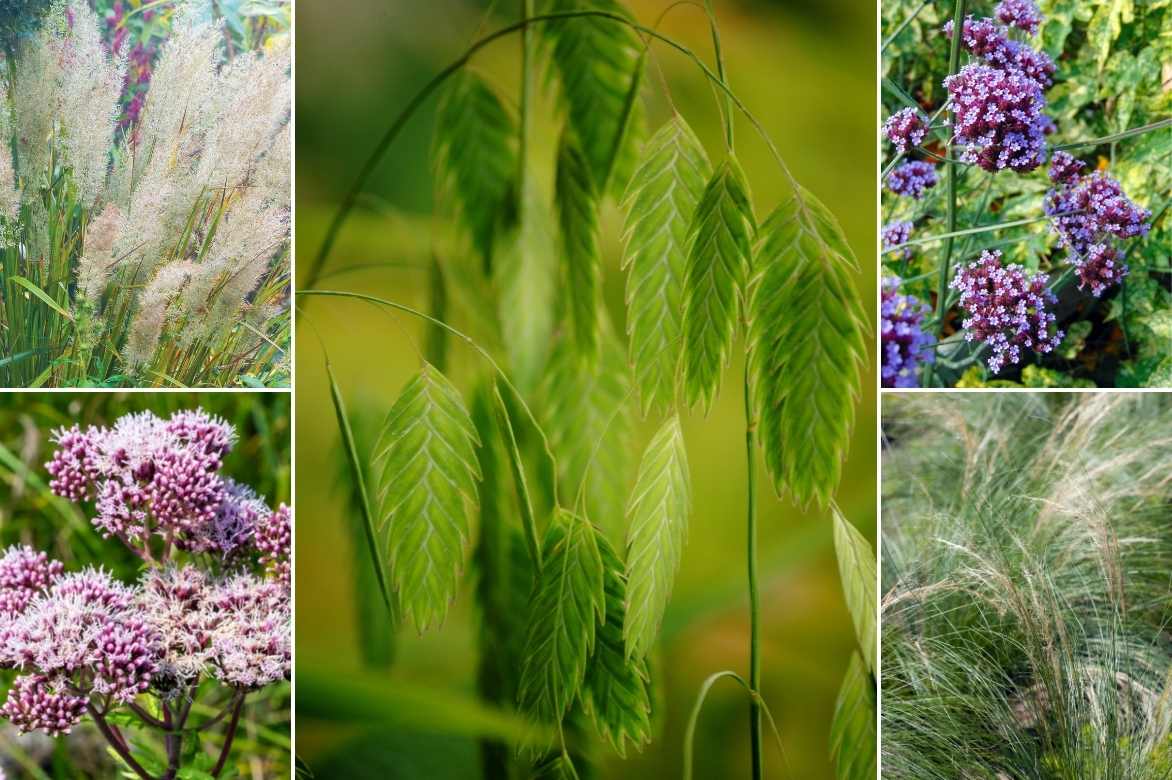
In a natural garden, pair Chasmanthium latifolium with eupatoriums and Buenos Aires verbenas, along with other soft grasses: Calamagrostis and Deschampsia cespitosa
Anecdotes
- In addition to its ornamental aspect, Chasmanthium latifolium is cultivated in the United States as a forage plant;
- The stunning inflorescences of wild oats are used in floral art, particularly in the creation of dried bouquets;
- The genus name Chasmanthium comes from the Greek χάσμα (chasma), meaning “widely open,” and άνθος (anthos), meaning “flower.” This refers to the particular shape of the “flowers,” the spikelets, of wild oats.
- The Latin name of the species “latifolium” means “broad-leaved.”
Useful resources
Find all our chasmathiums in our online nursery.
- Subscribe!
- Contents































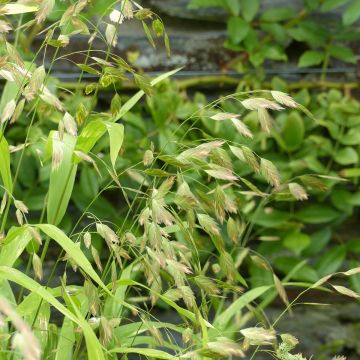
Comments